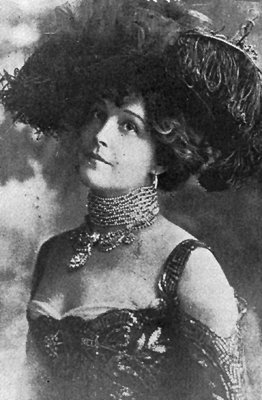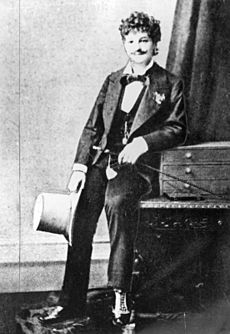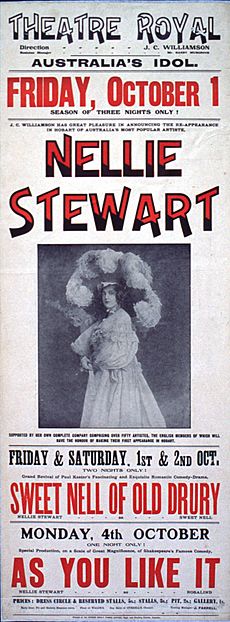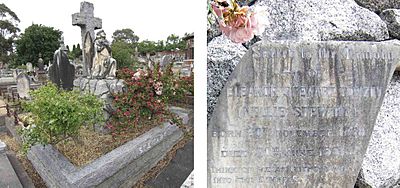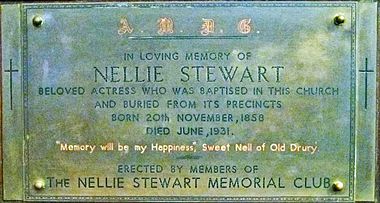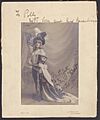Nellie Stewart facts for kids
Nellie Stewart, born Eleanor Stewart Towzey (20 November 1858 – 21 June 1931), was a famous Australian actress and singer. People often called her "Our Nell" or "Sweet Nell."
Nellie grew up in a family of performers, so she started acting when she was just a child. As a young woman, she became well-known for her roles in operettas and Gilbert and Sullivan operas. In the mid-1880s, she began a long partnership with theatre manager George Musgrove. Later, Nellie took some time off from performing, partly because her voice was tired from overwork. She also had a daughter with Musgrove during this break.
In 1902, Nellie had one of her biggest successes playing the main character in Sweet Nell of Old Drury. She found another hit show a few years later with Sweet Kitty Bellairs. After these successes, she continued to act in both comedies and dramas. She also worked in theatre management throughout the 1920s, showing her lasting dedication to the stage.
Contents
Nellie Stewart's Early Life and Career
Nellie Stewart was born in Woolloomooloo, Sydney, on 20 November 1858. Her father, Richard Stewart, was an actor and singer. Her mother, Theodosia Yates, was also an actress from a famous theatre family. Nellie's mother came to Australia in 1840 and played important roles in operas. With such a family, it's no surprise Nellie loved the theatre!
Nellie grew up with strict rules. Her family moved to Melbourne, where she went to school. She learned fencing from her father and dancing from Henry Leopold. Later, she took singing lessons from David Miranda.
Starting Her Acting Journey
When Nellie was about five years old, she had a small part in a play called The Stranger with famous actor Charles Kean. As she grew older, she played children's roles in pantomimes. In 1877, she sang and danced in seven different parts in a family show called Rainbow Revels. The next year, 1878, she played Ralph Rackstraw in an early Melbourne show of H.M.S. Pinafore.
In 1879, Nellie joined her father's theatre group. They toured India and then went to the United States, performing in smaller towns.
Becoming a Star Performer
Near the end of 1880, Nellie was offered a main role in Sinbad the Sailor in Melbourne. She took the part, and the show was a huge hit, running for 14 weeks! This success helped Nellie become more recognized. In 1881, she played Griolet in La fille du tambour-major and the Countess in Olivette.
For the next 13 years, Nellie played leading roles in 35 comic operas, including many by Gilbert and Sullivan. For example, in December 1883, she played the main character in Patience. One time, while playing the main boy in a Christmas pantomime, Nellie fell and broke her arm while climbing a beanstalk. But she had it set right there in the theatre and finished the show! She later said her understudies (actors who learn a part to fill in if needed) almost never got a chance to perform.
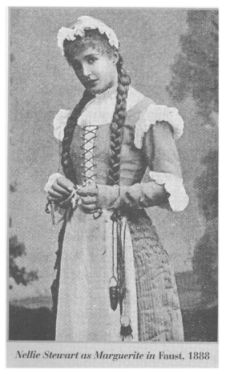
On 26 January 1884, Nellie married Richard Goldsbrough Row. She later called it "a girl's mad act" because she quickly realized she didn't love him. They separated within a few weeks, and Nellie went back to her theatre work. Over the next three years, she played many important parts, including Mabel in The Pirates of Penzance, Phyllis in Iolanthe, and Yum-Yum in The Mikado.
Nellie was very popular with audiences. Around this time, she started working closely with the well-known theatre manager, George Musgrove. Their partnership lasted until his death. Nellie greatly admired him and dedicated her autobiography, My Life Story, to his memory.
London and Later Successes
In 1887, Nellie took a year off from the stage and went to London with Musgrove. She returned to Australia in January 1888 to perform in Dorothy. In March 1888, she sang Marguerite in Charles Gounod's Faust in Melbourne for 24 nights in a row! This was amazing, but it might have been the start of her voice problems. In April 1888, she played Elsie in The Yeoman of the Guard, earning her highest salary yet.
In 1889, she had a successful season in Paul Jones. Then she went to London again to play Susan in a show called Blue-eyed Susan. This play wasn't very good, and Nellie felt nervous in London, so she didn't always sing her best. She felt sad and later wrote that she couldn't show her usual lively personality. She took another two years off. During this time, she had a daughter, Nancye Doris Stewart (1893–1973).
In September 1893, Nellie returned to Australia and performed in nine different operas. These included Gianetta in The Gondoliers and the main role in La Cigale. Over the next two years, she also had hits in Ma mie Rosette and Mam'zelle Nitouche.
Return to the Stage and "Sweet Nell"
In 1895, Nellie went back to London. She didn't appear on stage for four years, except for one small part. During this time, Musgrove had a big hit with The Belle of New York. Nellie returned to the stage at Christmas 1899 as the main boy in the Theatre Royal, Drury Lane pantomime, The Forty Thieves. She earned £50 a week and loved working in such a famous theatre. She was cast for the next year's pantomime but got sick on opening day and returned to Melbourne.
When the Duke and Duchess of York visited Australia to open the first federal parliament, Nellie sang the ode "Australia." In February 1902, she got one of the most important roles of her career: Nell Gwynne in Sweet Nell of Old Drury. This play made her famous as "Our Nell" and "Sweet Nell." Other comedy roles followed in Mice and Men and Zaza. In Zaza, Nellie earned her highest salary ever: £80 a week!
In 1904 and 1905, she added Pretty Peggy and Camille to her list of plays. She then visited America, and Sweet Nell was a big hit in San Francisco, California. They planned to go to New York, but the 1906 San Francisco earthquake destroyed all their stage sets, so they had to stop the tour. Nellie returned to Australia.
It wasn't until 1909 that she had another big success in Sweet Kitty Bellairs. She performed this show along with Zaza, Rosalind in As You Like It, and Sweet Nell for a long time. In March 1910, she tried a pure comedy role as Maggie Wylie in What Every Woman Knows. She also played Princess Mary in When Knighthood was in Flower and the main role in Trilby. In 1911, she made her only film, playing the title character in Sweet Nell of Old Drury, just like her stage hit.
Later Years and Legacy
After this, Nellie faced a difficult period. World War I affected theatres, and she lost almost all her savings. In 1915, she toured New Zealand and received great reviews. In January 1916, she was very sad after George Musgrove died. But Hugh Donald McIntosh convinced her to perform again in a shorter version of Sweet Nell. He also hired her to help produce London hits like Chu Chin Chow and The Lilac Domino. Later, she did similar work for J. C. Williamson Limited.
In 1923, Nellie published her autobiography, My Life's Story, which tells her interesting life story. In her later years, she sometimes performed for charity events. Once, when she was over 60, she even played Romeo in the balcony scene from Romeo and Juliet, with her daughter Nancye playing Juliet! When she was almost 70, she had an amazing return to the stage in Sweet Nell of Old Drury. In July 1930, she took on the emotional role of Cavallini in Romance.
On 24 March 1931, the Columbia Graphophone Company recorded Nellie Stewart and others performing parts of Sweet Nell and a speech she gave to her fans. Two months after Nellie's death, in August 1931, Columbia gave the original recordings to the Mitchell Library.
Nellie Stewart's Impact
Nellie Stewart was truly special on the Australian stage. She was beautiful, lively, and a natural actress. She also had a wonderful soprano voice, which she sadly lost in middle age, probably from overusing it. She took her acting very seriously, lived carefully, and always stayed in shape. She was very good at playing younger roles even when she was older.
Nellie was very versatile. After being a top performer in light opera for many years, she was able to take on leading roles in non-musical comedies and dramas even after losing her singing voice. While she wasn't considered the greatest actress ever, she was very effective in both emotional and funny parts. Her autobiography shows she was a kind and charming person who appreciated others' work and avoided the usual drama of stage life. Australian theatre-goers, both men and women, admired, loved, and respected her for 50 years.
Nellie Stewart's Passing
Nellie Stewart passed away at age 72 on 21 June 1931, at her home in Mosman, New South Wales. Her illness was short, caused by heart problems and pleurisy. Large crowds gathered in Sydney for her funeral on 24 June 1931. People lined the streets and filled St. James' Church for the first service. Nellie's body was cremated at Rookwood Necropolis in Sydney after another service, and her ashes were taken to Melbourne. After more services attended by many people, her ashes were placed in her family's grave at Boroondara General Cemetery in Kew on 27 June 1931. Her daughter, Nancye, survived her.
How Nellie Stewart is Remembered
"Nellie Stewart bangles" became a popular fashion trend for young Australian and New Zealand women in the late 1800s and early 1900s. These bangles were usually worn on the upper arm, just like Nellie Stewart wore hers. In 1886, Nellie received 25 gold coins as a thank-you for supporting a fund to remember General Gordon. She had these coins made into a simple bangle, which she wore on her upper arm for the rest of her life. Jewelers like Angus and Coote even sold these bangles!
In 1930, a portrait of Nellie Stewart was painted by W. B. McInnes. You can see it in the collection of the National Gallery of Victoria in Melbourne. From 1933, the "Nellie Stewart Memorial Cup" was given as a prize in Junior Theatre League drama contests for the best Australian play performance. In 1934, a "Nellie Stewart Memorial committee" was formed to help Sydney Hospital, which Nellie had supported. This committee also raised money for a monument to Nellie. In 1936, a rose garden was created and named the "Nellie Stewart Garden of Memory" at the Botanic Gardens, Sydney. A stone memorial with a carving of Nellie was placed there in 1938.
In 1989, Australia Post issued a $1 postage stamp honoring Nellie Stewart along with J. C. Williamson. In 2001, an exhibition at the Arts Centre, Melbourne, celebrated 70 years since Nellie's death.
Images for kids


